Pet Woodlice 101: How To Identify, House & Take Care Of A Woodlouse
Woodlice are amazing and often much maligned little animals, that are well worth a second look.
There are 3,500 species of Woodlice in the world and about 35 (or 1%) of these live in the UK. Though many of these are small and difficult to find, there are few larger species that are regularly found around buildings.
The common species are abundant in most habitats, and are easy to keep in margarine containers as they are incapable of climbing up the sides, some damp soil on the bottom and some house-hold vegetable scraps added occasionally and you have some great pets.
Keep the soil damp but not too wet as excess moisture can kill pet Woodlice as easily as too little. Though the Woodlice will feed on the scraps that you put in they will also feed on their own faeces, this is quite natural, what they are actually eating is the fungi and bacteria that are living on the faeces. Some species mostly of the genera Armadillidium, commonly called Pill Bugs, are capable of rolling themselves up in a ball, this is a defence against desiccation as well as against predators such as shrews which find it much harder to bite a ball than an unrolled Woodlice.
If you find a dead woodlouse or cool one down in the fridge so that you can count the legs you will find that it has fourteen, seven on each side, from this you can realise that woodlice are not insects. They are Arthropods though, and share with Insects, Arachnids (Spiders and Scorpions etc) and Myriapods (Millipedes and Centipedes) a hard exoskeleton and jointed limbs; they are in fact members of the Subphyllum Crustacea, and therefore more related to crabs and prawns than to other terrestrial arthropods. Nearly all the Arthropods that live in the see are Crustaceans but Woodlice, and a few Amphipods, are the only Crustaceans to live on land with any great success.
Woodlice: An Endearing Pet!
Woodlice have endeared themselves to many people’s hearts in the past and there are numerous common names for those species which frequent human habitation, such as Bibble bugs, Cheesy bugs, Cud-worms (a reference to their use by farmers in the past to promote restoration of the cud) Coffin-cutters, Roly Poly, Monkey peas, Penny pigs, Sink-lice, Slaters, Sowbugs and Tiggyhogs.
Though not everyone has liked them, in some parts of Britain in the past their presence in a house has been considered as unlucky and any food they walked over as poisoned. In other places they have been considered a remedy for stomach upsets and diseases of the liver when eaten live, their cuticle contains a lot of calcium carbonate so it is possible eating them may help cure acid stomach.
Woodlice like most Crustaceans are quite edible and Vincent M. Holt in his book “Why not eat Insects” maintains that for making a seafood sauce woodlice are superior to prawns.
When a Woodlice is born it only has 6 pairs of legs, and is very vulnerable to desiccation (drying out) for the first part of its life it lives in a brood pouch underneath its mother, this pouch is composed of plates on the underside of segments 2-5, and is called a ‘marsupium’ and is grown especially by pregnant females for this purpose, at this age a young woodlouse is called a ‘manca’. After its first moult it gains its 7th pair of legs and leaves the marsupium. Like insects and all other arthropods growth can only occur at times of moult, but unlike insects Woodlice only shed half their skin at a time.
When approaching the time to moult a Woodlice stops eating for a few days, then its skin splits around its middle and it sheds the back half of its skin, and then a few days later it sheds the front half, woodlice often eat their shed skin. The Woodlouse is very vulnerable during this time, and often seek a spot away from its fellows for the duration of its shedding, in fact some species, though not any British ones build themselves a cocoon to hide in while they shed their skins, In cultures a certain amount of cannibalism of shedding individuals may occur, particularly if the container is crowded.
In nature many Woodlice die while they are still young and the older they get the more chance there is of them surviving to breed. Most of the larger species do not breed until they are at least 2 years old. Nearly all Woodlice are herbivores and many feed on dead and rotting vegetation, or the microbial flora that infests such material. Ligia oceanica (Common Sea Slater) is the largest species in Britain, up to 30 mms long, it lives only on the seashore and feeds mainly on the brown seaweed Fucus vesiculosus, while Porcellio scaber a common woodland species likes to feed on tree bark but will eat many other things.
There are some carnivorous Woodlice, though not in Britain, in the genus Tylos , such as Tylos latreillei a Mediterranean species which lives on the seashore and feeds nocturnally on Sandhoppers.
Experiments To Try With Pet Woodlice
Humidity Response
To start this experiment you will need several petri-dishes with two pieces of filter paper in the bottom of them, in half of them the filter paper should be dry and in the others it should be thoroughly damp.
You will also need a number of pet Woodlice of each species you wish to test keep one third of them in a container that is absolutely soaking in water so that the Woodlice almost have to swim, one third in a container that is completely dry and one third in a container that has a damp substrate similar to that which you would keep them in normally (see above), for about half an hour.
Then put one Woodlouse from each preliminary condition into one of each of the petri-dishes described first. Put the Woodlouse in the centre and then put the lid on and use a marker pen to record the Woodlouse’s position every 15 seconds for about ten minutes. You do not need to do all the different combinations at the same time as long as your preparation is the same each time. After ten minutes let the Woodlouse go back to its normal home and work out both the total distance covered by the woodlouse, and the number of times the Woodlouse made a turn of more than 90 degrees.
You can divide the total distance in millimetres by the number of turns greater than 90 degrees to get an activity number if you like. If you have more time try comparing not only different species but also individuals within a species and one individuals responses on a series of days to see if it remains constant. Do your pet Woodlice respond differently to the different treatments.
Do Woodlice have a Permanent Home?
For this you will need a fish tank or something similar about 45 to 60 cms long by 20 to 30 cms wide, the bigger the better, with a centimetre or so of damp soil on the bottom and four identical shelters. Place the shelters at random in the tank, spread some food around the tank bottom and then place a Woodlouse under one of the shelters, is it under the same one the next day.
Record its movements for a week, does it use one more often than the others. You can now try the experiment with four of your pet Woodlice, mark each one with a different colour of paint and record their movements for a week, now try it with four of each colour under each shelter. Do the Woodlice in groups respond differently to the individual one. You can run this experiment for as long as the paint allows you to tell who is who if you like.
As an extension of this experiment you could set up shelters for woodlice in some open ground, a flat piece of 3-ply about 20 cms square with 4 pieces of timber 20 cms long, and 2 cms by 2 cms square on all four edges to hold it off the ground will do fine. Leave them outside for a week, then mark all the woodlice under each shelter use a different colour for each shelter, and check them each day after that for two weeks or until the paint wears off recording how many of each colour are under each shelter.
Collection, Preservation and Care of Woodlice
Woodlice occur in a wide range of habitats and can be searched for almost anywhere. The most productive sites are those which provide numerous crevices and microsites where the woodlice can hide. Thus, damp leaf litter, rotting wood, loose bark, piles of rocks in disused quarries, and ‘mature’ tips of household refuse and rubble are ‘good’ sites. Six species of woodlice are found only on the coast (under boulders, in rock crevices and under driftwood) and are much easier to find at night (with a torch) when they come out to feed. Harding and Sutton (1985) provide a detailed analysis of habitat preferences of British woodlice based on the results of the Isopod Survey Scheme.
Hand-searching among surface material (‘grubbing about’), or even direct observation, will turn up many of the larger species of woodlice. In a Bristol garden, for example, I have observed large numbers of Armadillidium depressum walking over a brick wall in full sunlight on a hot July day with no apparent distress. However, some species are vulnerable to drying out, particularly the small soil-dwelling forms. These can be found only by digging into the soil, or by turning over deeply-embedded boulders.
Remember to look very closely on the underside of such stones and in the cavities from which the boulders were dislodged (and to put the rocks back when you have finished!). Pitfall traps may be useful for sampling in areas from which it would otherwise be difficult to collect (e.g. shingle beaches) and sieving humus onto a tray may turn up some of the more inconspicuous soil species. Sutton (I972) and Chalmers and Parker (I989) contain detailed discussions of collection methods and techniques.
For the beginner, a hand lens of at least 10 x magnification is essential for the identification of specimens in the field. With experience, it is possible to recognise most of the larger species with the naked eye. Other useful equipment includes a strong penknife for levering bark from rotting wood (try not to remove more than IO% of this from each log) and a pair of weak ‘storksbill’ forceps. Smaller species can be picked up with a moistened paintbrush.
Identification of larger species of woodlice can be attempted with live specimens in the field by holding them between the first finger and thumb (woodlice do not bite or sting!), or restraining specimens in a suitable holding and viewing device (see JonesWalters, 1989, for examples). The smaller ‘pygmy’ woodlice (Family Trichoniscidae) are more delicate and can be examined with a hand lens while still attached to a piece of substratum such as a small lump of soil or fragment of bark.
Most species will survive for several days in self-seal Polythene bags on which site details can be written with an indelible pen. Some leaf litter, or moss, from the collection site should be included and the bags should be kept cool and away from direct sunlight. Tiny specimens are best placed individually in small glass or plastic tubes with tightly fitting lids. Using such methods, live woodlice are safely transported back to the laboratory/classroom for more detailed observation. Alternatively, woodlice can be placed directly in preservative in the field. However, by doing this, many characters which are extremely helpful in identification (some colours, number of lungs, behaviour etc.) will be lost.
Woodlice cannot be set and pinned in the same way as insects. Because their cuticle is heavily calcified, woodlice become very brittle when dry. Therefore, they must be immersed permanently in a preservative such as 70% alcohol (i.e. 3 parts water to 7 parts alcohol or clear industrial methylated spirit). Specimens are kept ideally in glass tubes with tightly-fitting plastic tops.
It is essential to include a label (inside the tube) on which is written, in pencil or indelible ink, the Name of the species, the Collector (even if it is you), the Locality, the Ordnance Survey Grid Reference and the Date on which the specimen was collected, Remember, someone may want to consult your specimen in 100 years time; accurate labels are very important.
Positive identification of a few of the small species of woodlice may require removal and examination of the pleopods and 7th legs of a male these must be preserved as a slide, it is best to check with biological suppliers as to current recommended chemicals since new products appear on the market all the time.
Woodlice Cultures
Some people may not regard woodlice as the most stimulating of pets, but most species breed readily in captivity and make an interesting addition to a classroom or laboratory display. Ideal containers are clear plastic sandwich boxes containing a thin layer of soil, a few pieces of bark and some leaf litter.
The addition of a few shreds of grated carrot every week, and a light spray with water, will keep the cultures healthy. Care should be taken not to make conditions too damp since woodlice are just as easily killed by conditions being too moist as being too dry.
The Isopod Recording Scheme
In common with many other groups of animals, an active recording scheme exists for woodlice in Britain. This is coordinated by the Biological Records Centre (BRC) of the Natural Environment Research Council’s Institute of Terrestrial Ecology at Monks Wood Experimental Station.
The Isopod Survey Scheme was established in 1968 and, to date, more than 30,000 individual species records have been submitted. Harding and Sutton (1985) give a detailed account of the development of the Isopod Survey Scheme, together with habitat information and distribution maps for records received until August 1982. These maps still provide an accurate picture of the general distribution of most woodlice in Britain and Ireland.
However, the known ranges of some species have been extended since 1982, probably as a result of increased collecting rather than a true ecological expansion. Maps of 14 species, including records to 1987, have been published by Hopkin (I987), and more detailed surveys of local areas have been reported for Reading (Hopkin, 1988), Cornwall (Jones, 1987) and the Isles of Scilly (Jones and Pratley, 1987). Maps of the distributions of Trachelipus rathkei and Armadillidium pictum, which include records subsequent to Harding and Sutton (I 985), have also appeared recently (Whitehead, 1988; Richardson, 1989). The notes on distribution in the individual descriptions of species, includedhereafter the key, give up-to-date information based on records received to August 1991.
New recorders are welcome to join the Isopod Survey Scheme which currently has about 150 members. Those registered receive a newsletter twice a year and are encouraged to participate in the annual field meeting held jointly with the British Myriapod Group. A journal ‘Isopoda’ is also published which contains a variety of articles on terrestrial and freshwater isopods and amphipods. Write in the first instance to BRC (address below) who will forward your enquiry to the current scheme organiser.
Isopod Survey Scheme, Biological Records Centre, Monks Wood Experimental Station, Abbots Ripton, Huntingdon, Cambs PE17 2LS.Key to Commoner Woodlice of Britain
Earlier keys to British woodlice have proved difficult for the beginner to use. Edney’s (1954) Synopsis was a specialist’s key which relied at many points on characters which were difficult to see with a hand lens, or required dissection.
Also, some of the features that were used are not visible in specimens preserved in 70% alcohol. Sutton, Harding and Burn’s key (included in Sutton, 1972) contained a number of clear and accurate line drawings, together with a series of beautiful colour paintings of a selection of species. This key was easier to use as it relied, as far as possible, on characters which could be seen with the naked eye, or a hand lens.
Publication of Sutton, Harding and Burn’s key stimulated an upsurge in interest in woodlice. There is now a need for a new key which incorporates up-to-date information on distribution and descriptions of the seven species discovered in Britain since 1972.
It is hoped that publication of this key below will encourage further interest in ‘grammerzows’, ‘chiggy pigs’ and ‘cheeselogs’!
1a] Specimen can role into a ball, may or may not have two short obvious tail like appendages………………..4
1b] Specimen can not role into a ball and always has two short obvious tail like appendages……………………2
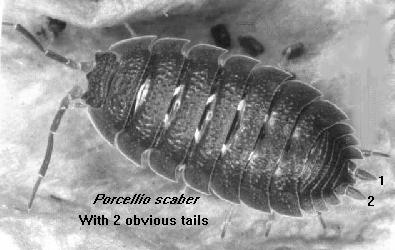
body, generally grey but often reddish, brownish or pale often with white spots .
Porcellio scaber (Common Rough Woodlouse)
2b] Specimen has no raised bumps on its back and is shinier………………3
3a] Specimen has a very clear darker line down its back, head generally the same darker colour as the central
stripe, runs very fast, commonly found in hedgerows and rough grassland, up to 11mm
Philoscia muscorum (Common Striped Woodlouse)
(Generally shiny and has green yellow, red and purplish forms)
3b] Specimen is generally greyish with splotchy white markings and sometimes an indistinct line along its back
Oniscus asellus (Common Shiny Woodlouse)
(Is larger than P. muscorum when full grown, up to 16mm and prefers damper habitats)
4a] Antennae not easily visible outside of rolled up body.
Armadillidium sp.
(Probably A. vulgare (Common Pill Woodlouse), there are other species found around buildings but
distinguishing them is difficult for the beginner, see below)
4b] Antennae easily visible outside of rolled up body ………………………….5
5a] Specimen has two small but obvious tails (Uropod, exopodites) extending beyond the end of the body,
and has 5 pairs of lungs** on the underside .
Cylisticus convexus (False Pill Woodlouse)
5b] Specimen does not have obvious tails as above, often with a row or two of mainly darker spots on the
sides of the body, has only 2 pairs of lungs**, on the underside.
Armadillidium nasatum (Southern Pill Woodlouse)
(only in Wales and England South of Hull, commonly found in garden centres)
** A Woodlouse’s lungs are visible as flat patches of white on the pleopods, these occur at the back end of the animal, after the legs when viewed upside-down, See fig 1.
Literature which might help includes:
- Cloudsley-Thompson, J.L. (1968). Spiders Scorpions Centipedes and Mites, Pergamon Press, Oxford. (Includes nice sections on Woodlice and Millipedes as well as on various Arachnids such as Solifuges)
- Harding, P.T. and Sutton, S. L. (1985). Woodlice in Britain and Ireland: Distribution and Habit. Institute of Terrestrial Ecology, Huntingdon.
- Hopkin, S. (1991). A key to the Woodlice of Britain and Ireland, An Aidgap Key. Richmond Publishing, Slough
- Sutton, S. L. (1972). Woodlice. Ginn and Co. London. (Republished by Pergamon Press, Oxford in 1980)

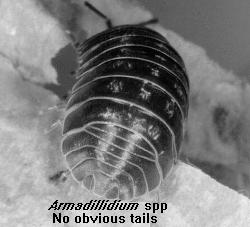
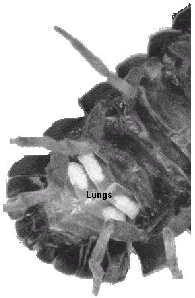
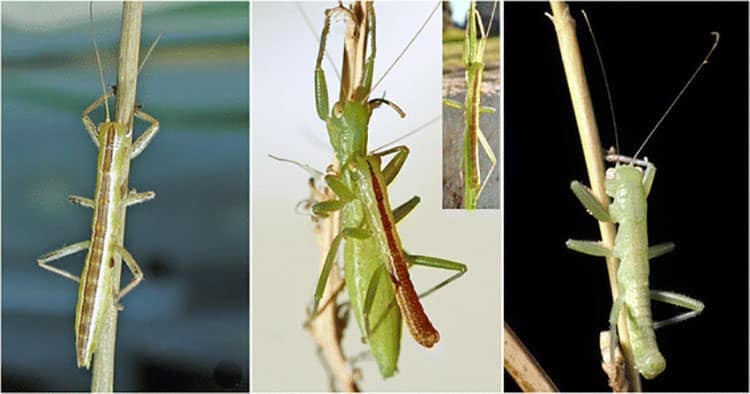
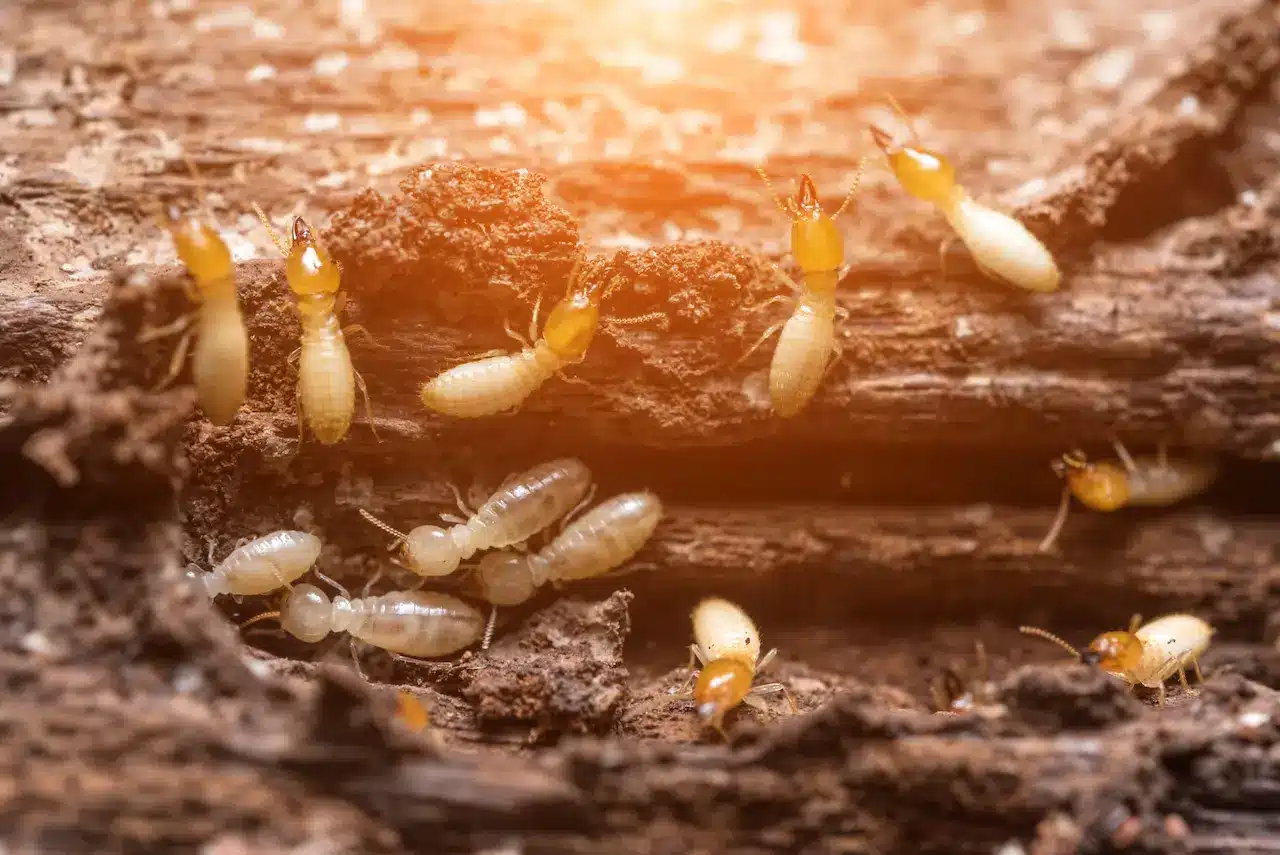


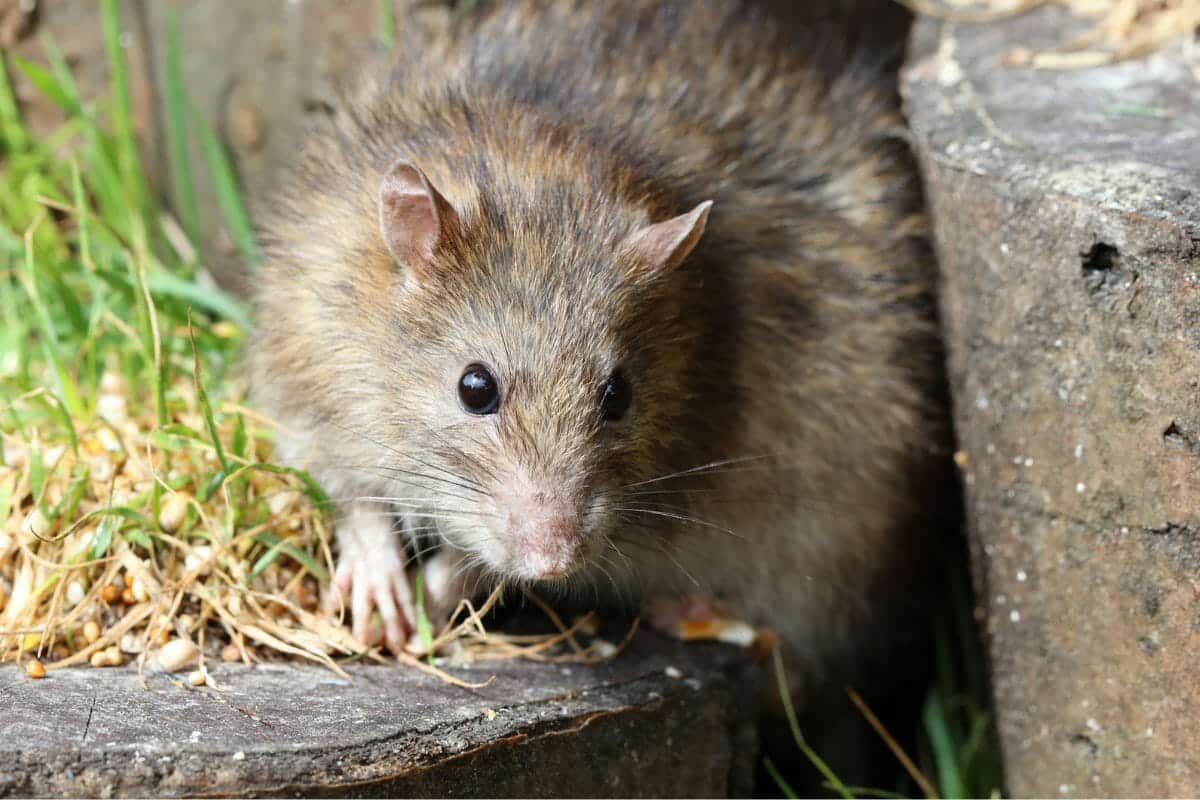
Thank you for this page. My kids and I just collected approximately 100 woodlice and we look forward to keeping them for a while and keying some of them out.